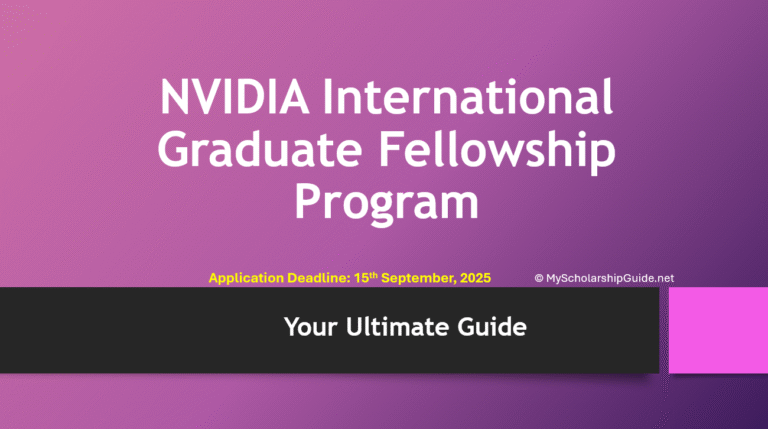How to Craft a Standout CV for Your Scholarship Application
How to Craft a Standout CV for Your Scholarship Application
The dream of studying abroad is a common one for many ambitious African students. But between the application forms, the personal statement, and the letters of recommendation, one document often trips people up: the Curriculum Vitae (CV). This isn’t just another piece of paper; it’s a powerful tool that tells your story in a professional, concise way. A generic CV won’t cut it. You need a document that screams “I am the ideal candidate!” to the scholarship committee.
Many students from across Africa worry that their local experience won’t be valued by international scholarship committees. They wonder if their part-time job at a local market, their leadership role in a university club, or their volunteering at a community center will be enough. The truth is, these experiences are your strengths. Your CV is your opportunity to reframe these experiences and showcase your unique journey. This comprehensive guide will walk you through how to craft a standout CV for your scholarship application, ensuring your unique story gets the attention it deserves. We’ll cover everything from formatting to content, helping you turn a simple document into your golden ticket.
Understanding the Difference: CV vs. Resume for Scholarships
Before you even start writing, it’s crucial to understand what a CV is and how it differs from a resume, especially in the context of a scholarship application. This isn’t just a matter of semantics; it’s about the purpose and scope of the document.
What is a CV?
A CV (Curriculum Vitae) is a comprehensive document that provides a detailed overview of your academic and professional accomplishments. The Latin phrase “Curriculum Vitae” means “course of life,” and that’s exactly what it is—a detailed history of your academic and work life.
- Key Characteristics:
- Length: A CV is typically longer than a resume, often spanning two or more pages, especially as your experience grows. For a scholarship application, a two-page CV is often a good target for students with some experience.
- Focus: It emphasizes your academic background, research, publications, presentations, and teaching experience.
- Usage: Predominantly used for academic, research, and scholarship applications. It’s the standard for higher education roles and is common in Europe, Africa, and parts of Asia.
What is a Resume?
A Resume is a concise, one-page summary of your skills, qualifications, and work history.
- Key Characteristics:
- Length: Almost always one page. The goal is to be brief and impactful.
- Focus: It’s more targeted and tailored to a specific job. It highlights skills and experiences most relevant to the position you’re applying for.
- Usage: Primarily used for job applications in the corporate world, especially in the United States and Canada.
Why Your Scholarship Application Needs a CV
For most international scholarships, a CV is the expected document. It allows you to present a detailed account of your academic journey and demonstrate a long-term commitment to your field. Scholarship committees want to see the full picture: your academic performance, your research interests, your skills, and how your experiences have shaped you. A CV, unlike a resume, gives you the space to tell this complete story.
Section-by-Section Breakdown: What to Include in Your Scholarship CV
Think of your CV as a structured narrative. Each section is a chapter, building on the last to tell a compelling story about your potential. Here’s a breakdown of the essential sections you need to include.
1. Contact Information
This section is non-negotiable. Make it clear and easy to find.
- Full Name: Use a professional font and size.
- Phone Number: Include your country code (e.g., +234 for Nigeria).
- Email Address: Use a professional-looking email (e.g., firstname.lastname@email.com), not something informal like soccerlover22@email.com.
- Physical Address: Include your city and country.
- Professional Links (Optional but Recommended): Include a link to your LinkedIn profile or a personal academic website if you have one. Make sure these profiles are updated and professional.
2. Education
This is often the most important section for a scholarship CV. List your degrees in reverse chronological order (most recent first).
- Format:
- Name of Institution: Federal University of Technology, Owerri.
- City, Country: Owerri, Nigeria
- Degree and Field of Study: (e.g., Bachelor of Science in Civil Engineering)
- Dates of Attendance: (e.g., 2021 – 2025)
- Key Highlights: Mention your grades or GPA if they are strong. You can also include your dissertation or thesis title.
3. Professional Experience or Work History
This section is where you showcase how your paid and unpaid work has prepared you for your chosen field of study. Don’t just list your duties; highlight your accomplishments.
- Format:
- Job Title:
- Company/Organization Name:
- City, Country:
- Dates of Employment:
- Bulleted List of Achievements: Use strong action verbs. Instead of “Responsible for managing a team,” write “Led a team of 5 volunteers to organize a community health outreach program, reaching over 200 people.”
- Important Tip: Quantify your achievements whenever possible. “Increased social media engagement by 50%” is much more powerful than “Managed social media accounts.”
4. Research Experience & Projects
For graduate-level scholarships, this section is a game-changer. It demonstrates your passion for your field beyond the classroom.
- Format:
- Project Title:
- Role: (e.g., Research Assistant, Team Lead)
- Institution/Lab:
- Dates:
- Description: Briefly describe the project’s objective, your specific contribution, and the outcome.
5. Skills
This is where you list both your hard and soft skills. This section helps the scholarship committee quickly identify if you have the necessary tools for success.
- Hard Skills:
- Languages: (e.g., English, French, Swahili) – Be sure to specify your proficiency level (e.g., Fluent, Professional Working Proficiency).
- Software: (e.g., MATLAB, SPSS, AutoCAD, Adobe Creative Suite).
- Lab Techniques or Tools: (e.g., PCR, HPLC).
- Soft Skills:
- Leadership:
- Teamwork:
- Problem-Solving:
- Communication:
6. Awards, Honors, and Publications
This section is optional. However, when an award is available, highlight any recognition you’ve received. This could include academic awards, scholarships you’ve already won, or articles you’ve published.
- Format:
- Name of Award/Publication:
- Date:
- Issuing Body: (e.g., The Dean’s List, International Journal of Research).
7. Volunteer and Leadership Experience
This section is particularly important for African students. Many scholarships, especially those focused on development and community impact, value this experience highly.
- Format:
- Position/Role: (e.g., Community Outreach Coordinator, President of the Debate Club)
- Organization Name:
- Dates:
- Description: Use a bulleted list to detail your responsibilities and, more importantly, the impact you had. For example, instead of “Managed club meetings,” write “Planned and executed weekly club meetings, increasing member attendance by 30% and leading to a successful regional competition.”
How to Craft a Standout CV for Your Scholarship Application: Key Strategies and Tips
Now that you know what to include, let’s talk about the strategies that will make your CV truly stand out from the crowd. This is where you transform a good CV into a great one.
1. Tailor Your CV for Each Application
Never use a one-size-fits-all CV. Just as you tailor a cover letter, you must tailor your CV for each scholarship application.
- Analyze the Scholarship: Read the scholarship description carefully. What skills and experiences are they looking for? If the scholarship emphasizes community service, make sure your volunteer section is front and center and detailed. If it’s for a research-heavy program, put your research experience first.
- Use Keywords: Many scholarship committees use Applicant Tracking Systems (ATS) to filter applications. Scan the scholarship description and use the keywords they use to describe the ideal candidate. If they mention “data analysis,” use that phrase instead of “analyzing numbers.”
2. Focus on Achievements, Not Just Responsibilities
This is a common mistake. Don’t just list what you did; explain what you accomplished.
- Responsibility-focused: “Assisted in managing inventory.”
- Achievement-focused: “Reorganized the inventory system, reducing stock discrepancies by 15% and saving the company an estimated ₦50,000 annually.”
3. Maintain Professional Formatting and Design
A well-formatted CV is easy to read and looks professional. A messy one suggests a lack of attention to detail.
- Font: Use a clean, professional font like Calibri, Arial, or Times New Roman. Stick to a font size of 10-12 points.
- White Space: Don’t overcrowd the page. Use margins and spacing to make the document easy on the eyes.
- Consistency: Be consistent with your formatting. If you use bold for job titles, use bold for all job titles.
4. Proofread, Proofread, and Proofread Again
A single typo can undermine your credibility. Read your CV aloud to catch awkward phrasing. Ask a friend, mentor, or career advisor to proofread it for you. A fresh pair of eyes can spot errors you’ve missed.
5. Don’t Be Shy About Your “Local” Experience
Your experiences in Africa are not a disadvantage; they are a unique selling point. A scholarship committee wants to fund a global perspective. Your leadership in a university club, your role in a local community project, or your part-time job that taught you resilience and resourcefulness are all valuable. Frame these experiences in a way that highlights the skills you’ve gained—leadership, problem-solving, adaptability, and teamwork.
Frequently Asked Questions (FAQs)
How long should my scholarship CV be?
For most students and recent graduates, a two-page CV is ideal. This provides enough space to detail your academic and professional history without overwhelming the reader. If you have extensive research or publication history, it may be longer, but for the average scholarship applicant, aim for a concise yet comprehensive two pages.
Do I need to include a photo on my CV?
In most cases, no. Unless the scholarship application explicitly asks for a photo, it is best to leave it off. Including a photo is often discouraged in many Western countries to prevent bias. Focus on your qualifications and achievements, not your appearance.
What if I don’t have a lot of work experience?
Scholarship committees understand that many students won’t have extensive professional experience. In this case, you should beef up other sections. Focus on your volunteer work, leadership roles in school clubs, relevant coursework, and any research or academic projects you’ve worked on. These experiences demonstrate your skills and commitment just as effectively as a paid job.
Can I include my high school information?
Generally, no. Once you have started your undergraduate degree, you should focus your education section on your university-level studies and beyond. The only exception would be if you won a major, highly prestigious award in high school that is directly relevant to the scholarship you are applying for.
Should I list my references on the CV?
It is generally not necessary to list your references on your CV. Instead, you can include the phrase “References available upon request” at the bottom of the document. The scholarship committee will ask for your references separately when they need them.
Your Next Steps to Success
You’ve made it through the breakdown of how to craft a standout CV for your scholarship application. Now, the real work begins. The most crucial takeaway is that your CV is a strategic document, not just a list of facts. It’s your opportunity to tell your unique story and prove that you are not just a good candidate, but the best candidate.
Take a moment to gather all your documents and experiences. Start by creating a “master CV” that includes everything you’ve ever done. Then, for each scholarship you apply for, tailor a specific CV from that master document. Highlight the most relevant experiences, use the right keywords, and proofread meticulously. Your scholarship journey is a marathon, not a sprint. By following these steps, you will be well on your way to securing the funding you need to achieve your academic dreams. Your future awaits—start crafting that winning CV today!
Disclaimer
Unless otherwise stated, www.myscholarshipguide.com is not affiliated with any of the scholarship providers listed on our website, nor do we process applications on behalf of any organization. The content provided is for informational purposes only, and visitors are encouraged to use this information at their own discretion.







